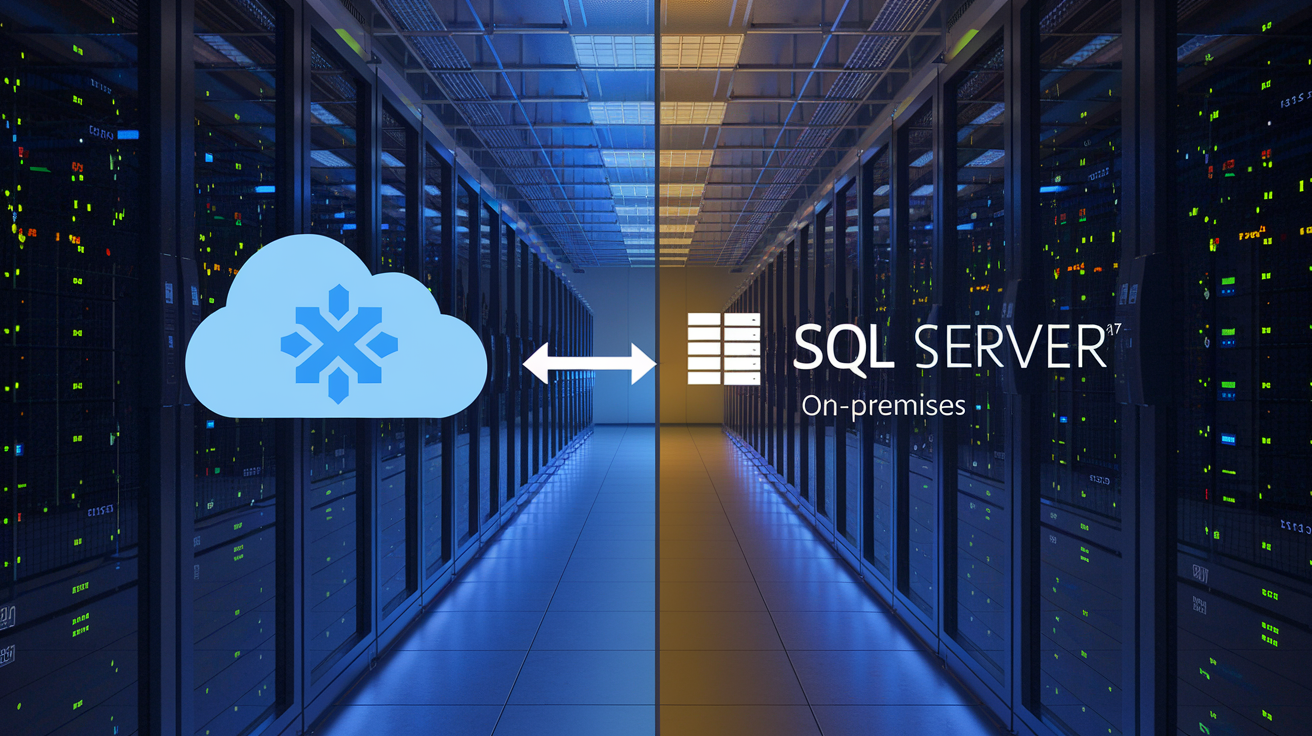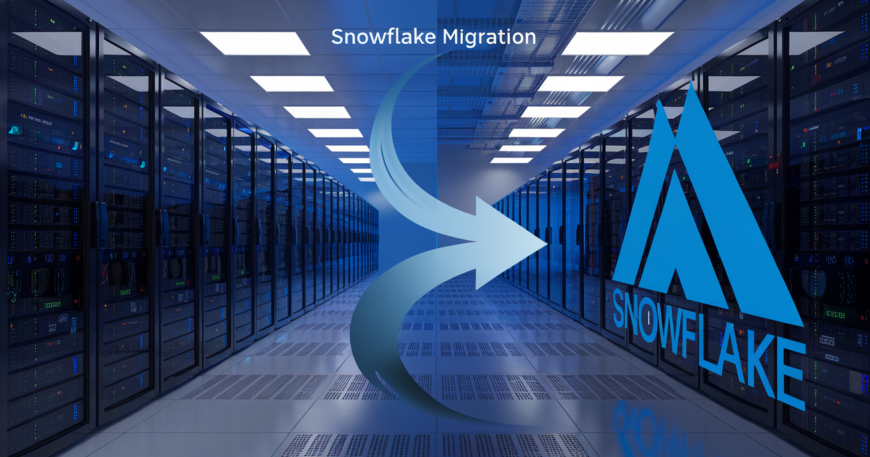In the ever-evolving landscape of data management, organizations are increasingly seeking more scalable, flexible, and cloud-native solutions. The migration from on-premises SQL Server 2017 to Snowflake represents a significant leap towards modernizing data infrastructure. But how can businesses navigate this complex transition without disrupting their operations?
Migrating from SQL Server to Snowflake isn’t just about moving data—it’s about transforming the way your organization handles, processes, and leverages its most valuable asset: information. 🚀 This shift promises enhanced performance, improved scalability, and reduced maintenance overhead. However, it also presents challenges in data migration, schema adaptation, and ensuring seamless continuity of business processes. Are you prepared to tackle these hurdles and unlock the full potential of your data in the cloud?
In this comprehensive guide, we’ll walk you through the entire journey of migrating from SQL Server 2017 to Snowflake. From understanding the fundamental differences between these platforms to executing a successful cutover, we’ll cover every crucial step. Let’s dive into the key aspects of this migration, including preparation strategies, data and schema migration techniques, performance optimization, security considerations, and essential testing procedures.
Understanding Snowflake and SQL Server 2017

Key differences between cloud-based and on-premises databases
As organizations increasingly move towards cloud-based solutions, it’s crucial to understand the fundamental differences between cloud-based databases like Snowflake and on-premises databases like SQL Server 2017. These differences impact various aspects of database management, performance, and scalability.
- Infrastructure and Maintenance
One of the most significant differences lies in the infrastructure and maintenance requirements:
| Aspect | Cloud-based (Snowflake) | On-premises (SQL Server 2017) |
|---|---|---|
| Hardware | Managed by provider | Owned and maintained by organization |
| Updates and Patches | Automatic | Manual or scheduled |
| Scalability | On-demand, elastic | Fixed, requires hardware upgrades |
| Physical Security | Managed by provider | Responsibility of organization |
Cloud-based solutions like Snowflake eliminate the need for organizations to manage physical hardware, reducing the burden on IT teams and allowing them to focus on more strategic initiatives.
- Cost Structure
The cost models for cloud-based and on-premises databases differ significantly:
- Cloud-based: Pay-as-you-go model, operational expenses (OpEx)
- On-premises: Upfront investment, capital expenses (CapEx)
Snowflake’s pricing model is based on actual usage, allowing organizations to scale resources up or down as needed without incurring unnecessary costs. This flexibility is particularly beneficial for businesses with fluctuating workloads or seasonal demands.
- Scalability and Performance
Cloud-based databases offer superior scalability:
- Snowflake: Separates storage and compute, allowing independent scaling
- SQL Server 2017: Tied to physical hardware limitations
Snowflake’s architecture enables organizations to scale compute resources instantly without affecting storage, ensuring optimal performance during peak usage periods.
- Availability and Disaster Recovery
Cloud-based solutions typically offer built-in high availability and disaster recovery features:
- Snowflake: Automatic data replication across multiple availability zones
- SQL Server 2017: Requires manual configuration and additional hardware
This difference significantly impacts business continuity planning and reduces the risk of data loss or downtime.
Advantages of migrating to Snowflake
Migrating from SQL Server 2017 on-premises to Snowflake offers numerous advantages that can transform an organization’s data management capabilities:
- Enhanced Scalability
Snowflake’s unique architecture allows for virtually unlimited scalability:
- Compute: Scale up or down instantly based on workload demands
- Storage: Automatically expands as data volume grows
- Concurrency: Support for multiple simultaneous queries without performance degradation
This scalability ensures that organizations can handle growing data volumes and increasing user demands without the need for complex capacity planning.
- Improved Performance
Snowflake’s optimized query engine and columnar storage format deliver superior performance:
- Faster query execution times
- Efficient handling of complex analytical workloads
- Automatic query optimization and caching
These performance improvements can lead to faster insights and improved decision-making processes across the organization.
- Simplified Management
Migrating to Snowflake significantly reduces administrative overhead:
- No need for index management or query tuning
- Automatic updates and patches
- Built-in monitoring and optimization tools
This simplification allows database administrators to focus on strategic initiatives rather than routine maintenance tasks.
- Cost Optimization
Snowflake’s pricing model offers potential cost savings:
- Pay only for actual usage (compute and storage)
- Ability to pause compute resources when not in use
- Separate billing for storage and compute
Organizations can optimize costs by aligning resource allocation with actual business needs, potentially reducing overall database management expenses.
- Advanced Data Sharing Capabilities
Snowflake’s unique data sharing features enable:
- Secure sharing of live data across organizations
- Creation of data marketplaces
- Seamless integration with third-party data providers
These capabilities can open up new opportunities for collaboration and data monetization.
- Enhanced Security and Compliance
Snowflake offers robust security features:
- End-to-end encryption (at rest and in transit)
- Role-based access control
- Column-level security
- Compliance with various industry standards (e.g., HIPAA, PCI DSS)
These security measures can help organizations meet stringent compliance requirements and protect sensitive data effectively.
Potential challenges in the migration process
While migrating from SQL Server 2017 on-premises to Snowflake offers numerous benefits, organizations should be aware of potential challenges:
- Data Migration Complexity
Transferring large volumes of data from on-premises to the cloud can be complex:
- Network bandwidth limitations
- Data integrity and consistency concerns
- Handling of legacy data formats
Organizations need to carefully plan and execute the data migration process to ensure data accuracy and minimize downtime.
- Schema and Code Conversion
Differences in SQL dialects and supported features may require adjustments:
- Stored procedures and user-defined functions
- Proprietary SQL Server features without direct Snowflake equivalents
- Data type mismatches
A thorough assessment of existing schemas and code is crucial to identify and address these differences during migration.
- Performance Tuning
While Snowflake offers excellent performance out-of-the-box, optimizing for specific workloads may require:
- Rewriting certain queries for better performance
- Adjusting data loading processes
- Fine-tuning warehouse sizes and auto-scaling policies
Organizations should be prepared to invest time in performance optimization post-migration.
- Change Management
Migrating to a new database platform involves significant changes:
- User training and adoption
- Updates to existing applications and reporting tools
- Adjustments to operational processes and workflows
Effective change management strategies are essential to ensure a smooth transition and minimize disruption to business operations.
- Cost Management
While Snowflake’s pricing model offers potential cost savings, it requires careful management:
- Monitoring and controlling resource usage
- Implementing proper governance policies
- Educating users on cost-efficient practices
Organizations need to implement robust cost monitoring and optimization strategies to maximize the benefits of the cloud-based model.
- Security and Compliance Considerations
Migrating to the cloud introduces new security considerations:
- Data residency and sovereignty requirements
- Integration with existing identity and access management systems
- Ensuring compliance with industry-specific regulations
A comprehensive security assessment and implementation plan is crucial to address these concerns effectively.
By understanding these potential challenges, organizations can better prepare for the migration process and develop strategies to mitigate risks. With proper planning and execution, the benefits of migrating to Snowflake can far outweigh the challenges, positioning organizations for improved data management capabilities and enhanced business agility.
Preparing for Migration

Assessing current SQL Server 2017 environment
Before embarking on the migration journey from SQL Server 2017 to Snowflake, it’s crucial to thoroughly assess the existing on-premises environment. This assessment provides a comprehensive understanding of the current infrastructure, data architecture, and performance metrics, serving as a foundation for a successful migration strategy.
Database Size and Growth
One of the primary considerations when assessing the SQL Server 2017 environment is the size of the database and its growth rate. This information is vital for capacity planning in Snowflake and estimating migration timelines. Use the following query to gather database size information:
SELECT
DB_NAME(database_id) AS DatabaseName,
CAST(SUM(size * 8.0 / 1024) AS DECIMAL(10, 2)) AS SizeInMB
FROM sys.master_files
GROUP BY database_id
ORDER BY SizeInMB DESC;
Create a table to track database growth over time:
| Database Name | Current Size (MB) | 3-Month Growth (%) | 6-Month Growth (%) | 1-Year Growth (%) |
|---|---|---|---|---|
| Database1 | 10,000 | 5% | 12% | 25% |
| Database2 | 5,000 | 3% | 8% | 15% |
| Database3 | 2,500 | 2% | 5% | 10% |
This information will help in determining the appropriate Snowflake edition and warehouse size for the migration.
Performance Metrics
Analyzing current performance metrics is essential to establish a baseline and set performance expectations for the Snowflake environment. Key areas to focus on include:
- Query performance
- CPU utilization
- I/O operations
- Memory usage
Use SQL Server Dynamic Management Views (DMVs) to gather this information. For example, to identify the top 10 resource-intensive queries:
SELECT TOP 10
qs.execution_count,
qs.total_worker_time / qs.execution_count AS avg_cpu_time,
qs.total_elapsed_time / qs.execution_count AS avg_elapsed_time,
qs.total_logical_reads / qs.execution_count AS avg_logical_reads,
qt.text
FROM sys.dm_exec_query_stats qs
CROSS APPLY sys.dm_exec_sql_text(qs.sql_handle) qt
ORDER BY qs.total_worker_time DESC;
This data will help in identifying potential performance bottlenecks and areas for optimization during the migration process.
Data Types and Compatibility
Assessing data types used in the SQL Server 2017 environment is crucial for ensuring compatibility with Snowflake. While Snowflake supports most SQL Server data types, some may require conversion or special handling. Use the following query to identify data types used across all tables:
SELECT
t.name AS TableName,
c.name AS ColumnName,
tp.name AS DataType,
c.max_length,
c.precision,
c.scale
FROM sys.tables t
INNER JOIN sys.columns c ON t.object_id = c.object_id
INNER JOIN sys.types tp ON c.user_type_id = tp.user_type_id
ORDER BY t.name, c.column_id;
Pay special attention to:
DATETIME2andDATETIMEOFFSET: Snowflake usesTIMESTAMPandTIMESTAMP_TZGEOGRAPHYandGEOMETRY: Snowflake supports these asGEOGRAPHYandGEOMETRYtypesHIERARCHYID: No direct equivalent in Snowflake, may require restructuring
Identifying data and schema to be migrated
After assessing the current environment, the next step is to identify the specific data and schema elements that need to be migrated to Snowflake. This process involves analyzing the existing database objects, determining their relevance, and prioritizing migration efforts.
Database Objects Inventory
Create a comprehensive inventory of all database objects in the SQL Server 2017 environment. This includes:
- Tables
- Views
- Stored Procedures
- Functions
- Indexes
- Constraints (Primary Keys, Foreign Keys, Unique, Check)
- Triggers
- Sequences
Use the following query to generate a summary of database objects:
SELECT
type_desc AS ObjectType,
COUNT(*) AS ObjectCount
FROM sys.objects
WHERE is_ms_shipped = 0
GROUP BY type_desc
ORDER BY ObjectCount DESC;
This information helps in understanding the complexity of the migration and identifying potential challenges.
Data Classification and Prioritization
Classify the data based on its importance, sensitivity, and usage frequency. This classification aids in prioritizing migration efforts and determining appropriate security measures in Snowflake. Consider the following categories:
- Mission-critical data
- Sensitive data (e.g., personal information, financial data)
- Historical data
- Archival data
Create a prioritization matrix to guide the migration process:
| Priority | Data Category | Migration Phase | Special Considerations |
|---|---|---|---|
| High | Transactional | Phase 1 | Minimal downtime required |
| High | Customer Data | Phase 1 | Data masking for PII |
| Medium | Analytical | Phase 2 | Optimize for Snowflake MPP |
| Low | Historical | Phase 3 | Consider data archiving |
Schema Analysis and Optimization
Analyze the existing schema structure and identify opportunities for optimization during the migration process. Consider the following aspects:
- Normalization level: Snowflake’s columnar storage and MPP architecture may benefit from a denormalized schema in some cases.
- Partitioning strategy: Evaluate current partitioning schemes and adapt them to Snowflake’s automatic micro-partitioning.
- Indexing: Snowflake doesn’t use traditional indexes, so identify alternative performance optimization techniques.
- Constraints: Determine which constraints are critical to maintain data integrity in Snowflake.
Use this opportunity to refactor and optimize the schema for better performance and maintainability in Snowflake.
Establishing migration goals and timeline
Setting clear migration goals and a realistic timeline is crucial for the success of the project. This step involves defining objectives, key performance indicators (KPIs), and a phased approach to migration.
Migration Objectives
Define specific, measurable objectives for the migration project. Examples include:
- Improve query performance by 30% for analytical workloads
- Reduce total cost of ownership (TCO) by 25% over three years
- Achieve 99.9% data accuracy post-migration
- Implement automated scaling to handle peak workloads
Key Performance Indicators (KPIs)
Establish KPIs to measure the success of the migration:
- Migration completion time
- Data validation success rate
- Query performance improvement
- Cost savings
- User adoption rate
Phased Migration Approach
Develop a phased migration plan to minimize risk and ensure a smooth transition. A typical phased approach might include:
-
Phase 1: Proof of Concept (PoC)
- Duration: 2-4 weeks
- Objectives: Validate architecture, test performance, identify potential issues
-
Phase 2: Non-Production Environment Migration
- Duration: 4-8 weeks
- Objectives: Migrate development and test environments, refine migration process
-
Phase 3: Production Data Migration
- Duration: 8-12 weeks
- Objectives: Migrate production data, perform thorough testing and validation
-
Phase 4: Cutover and Go-Live
- Duration: 1-2 weeks
- Objectives: Final data synchronization, application cutover, user training
-
Phase 5: Post-Migration Optimization
- Duration: Ongoing
- Objectives: Performance tuning, cost optimization, feature adoption
Selecting appropriate migration tools
Choosing the right migration tools is critical for ensuring a smooth and efficient transition from SQL Server 2017 to Snowflake. Consider the following categories of tools:
Data Migration Tools
- Snowflake Snowpipe: For continuous, real-time data ingestion
- Snowflake’s COPY command: For bulk data loading
- Third-party ETL tools: Such as Informatica, Talend, or Matillion
- Custom scripts: For complex transformations or specific requirements
Schema Migration Tools
- Snowflake’s Schema Migration Tool: Automates schema conversion from SQL Server to Snowflake
- SQL Server Migration Assistant (SSMA): Helps assess and convert schemas
- Custom scripts: For fine-grained control over schema conversion
Code Migration Tools
- Snowflake’s Stored Procedure Migration Tool: Converts SQL Server stored procedures to Snowflake JavaScript procedures
- Manual code conversion: For complex logic or unsupported features
Monitoring and Validation Tools
- Snowflake’s Query Profile: For performance monitoring and optimization
- Data validation tools: Such as SQL Data Compare or open-source alternatives
- Custom scripts: For specific validation requirements
When selecting migration tools, consider factors such as:
- Volume and complexity of data
- Required transformation logic
- Real-time vs. batch migration needs
- Team expertise and learning curve
- Budget constraints
- Integration with existing tools and processes
By thoroughly assessing the current SQL Server 2017 environment, identifying data and schema for migration, establishing clear goals and timelines, and selecting appropriate tools, organizations can lay a solid foundation for a successful migration to Snowflake. This preparation phase is crucial for minimizing risks, optimizing performance, and ensuring a smooth transition to the cloud-based data warehouse solution.
Data Migration Process

A. Extracting data from SQL Server 2017
The first step in the data migration process from SQL Server 2017 to Snowflake is extracting the data from the source system. This crucial phase sets the foundation for a successful migration. Here are the key considerations and methods for efficient data extraction:
- Data Assessment and Inventory
Before beginning the extraction process, it’s essential to conduct a thorough assessment of the SQL Server 2017 database. This includes:
- Identifying all tables, views, and stored procedures
- Analyzing data types and structures
- Evaluating data volumes and growth patterns
- Identifying any dependencies or constraints
- Extraction Methods
There are several methods to extract data from SQL Server 2017:
| Method | Pros | Cons |
|---|---|---|
| SQL Server Integration Services (SSIS) | Native to SQL Server, powerful ETL capabilities | Requires expertise, may have performance limitations for large datasets |
| Bulk Copy Program (BCP) | Fast for large data volumes, command-line utility | Limited transformation capabilities, requires scripting |
| SQL Server Management Studio (SSMS) Export | User-friendly interface, suitable for small datasets | Not ideal for large-scale migrations, limited automation |
| Third-party ETL tools | Advanced features, support for multiple databases | Additional cost, learning curve |
- Handling Large Datasets
For substantial data volumes, consider these strategies:
- Implement parallel extraction processes
- Use table partitioning to break down large tables
- Employ incremental extraction for frequently changing data
- Utilize compression techniques to reduce data transfer sizes
- Data Consistency and Integrity
Ensure data consistency during extraction by:
- Using transaction isolation levels
- Implementing proper locking mechanisms
- Considering point-in-time recovery options
- Metadata Extraction
Don’t forget to extract metadata along with the actual data:
- Table definitions and schemas
- Stored procedures and functions
- Indexes and constraints
- User-defined types and custom objects
- Performance Optimization
Optimize the extraction process to minimize impact on the source system:
- Schedule extractions during off-peak hours
- Use read-only replicas if available
- Implement proper indexing strategies
- Monitor and adjust resource allocation as needed
B. Transforming data to fit Snowflake’s structure
Once the data is extracted from SQL Server 2017, the next step is to transform it to align with Snowflake’s structure and capabilities. This transformation process ensures optimal performance and compatibility in the new environment.
- Data Type Mapping
SQL Server and Snowflake have different data type systems. Here’s a basic mapping guide:
| SQL Server Data Type | Snowflake Data Type |
|---|---|
| INT | NUMBER(38,0) |
| BIGINT | NUMBER(38,0) |
| DECIMAL(p,s) | NUMBER(p,s) |
| VARCHAR(n) | VARCHAR(n) |
| DATETIME | TIMESTAMP_NTZ |
| VARBINARY | BINARY |
- Handling Unsupported Features
Some SQL Server features may not have direct equivalents in Snowflake. Address these during transformation:
- Replace SQL Server-specific functions with Snowflake alternatives
- Refactor complex stored procedures into simpler, Snowflake-compatible logic
- Adjust identity columns to use Snowflake’s auto-incrementing features
- Data Cleansing and Standardization
Use the transformation phase as an opportunity to improve data quality:
- Remove duplicate records
- Standardize formats (e.g., dates, phone numbers)
- Handle NULL values appropriately
- Correct inconsistent or erroneous data
- Schema Optimization
Optimize the schema for Snowflake’s columnar storage:
- Denormalize data where appropriate
- Consider clustering keys for frequently queried columns
- Evaluate the need for materialized views
- Encoding and Compression
Prepare data for Snowflake’s automatic compression:
- Convert text-based data to appropriate numeric types where possible
- Consider pre-compressing large object data (LOBs)
- Handling Complex Data Types
Transform complex SQL Server data types to Snowflake-compatible formats:
- Convert spatial data to WKT (Well-Known Text) format
- Transform XML data to Snowflake’s VARIANT type or flatten into relational structures
- Convert hierarchical data to Snowflake’s ARRAY or OBJECT types
C. Loading data into Snowflake
After transforming the data, the next step is to load it into Snowflake. This process involves transferring the prepared data and ensuring it’s correctly inserted into the target Snowflake tables.
- Choosing a Loading Method
Snowflake offers several data loading options:
- COPY command: Efficient for bulk loading from staged files
- Snowpipe: For continuous, incremental data loading
- External tables: For querying data directly from external storage
- INSERT statements: For smaller datasets or real-time inserts
- Staging Data
Before loading, stage your data in a location accessible to Snowflake:
- Internal stages: Managed by Snowflake, suitable for temporary staging
- External stages: Cloud storage services like AWS S3, Azure Blob Storage, or Google Cloud Storage
- User stages: Personal file staging areas for individual users
- File Format Considerations
Choose appropriate file formats for optimal loading performance:
- CSV: Simple and widely supported
- JSON: Ideal for semi-structured data
- Parquet or ORC: Columnar formats for improved compression and query performance
- Bulk Loading Best Practices
To maximize loading efficiency:
- Use parallel loading for large datasets
- Compress files before staging to reduce transfer times
- Utilize Snowflake’s automatic clustering during load
- Consider using the COPY command with the FORCE option for resilience against errors
- Error Handling and Validation
Implement robust error handling during the load process:
- Use Snowflake’s data validation features
- Implement pre-load validation checks
- Set up error logging and notification systems
- Create a process for handling and reloading rejected records
- Monitoring and Optimization
Continuously monitor and optimize the loading process:
- Use Snowflake’s query history and system views to track load performance
- Adjust virtual warehouse size as needed for improved throughput
- Implement load balancing for concurrent loading operations
D. Validating migrated data for accuracy and completeness
The final and critical step in the data migration process is validating the migrated data to ensure accuracy and completeness. This phase is essential to maintain data integrity and build confidence in the migration process.
- Row Count Verification
Start with a basic comparison of row counts between source and target:
- Compare total row counts for each table
- Verify row counts for specific date ranges or other key dimensions
- Investigate and resolve any discrepancies
- Data Integrity Checks
Perform comprehensive data integrity validations:
- Verify primary key uniqueness
- Check foreign key relationships
- Validate constraints and business rules
- Ensure data type consistency
- Statistical Validation
Use statistical methods to validate large datasets:
- Compare column-level statistics (min, max, average, standard deviation)
- Use sampling techniques for detailed comparisons of large tables
- Employ data profiling tools to identify anomalies or patterns
- Functional Testing
Conduct functional tests to ensure the migrated data supports business processes:
- Run critical business queries and compare results
- Verify aggregations and calculations
- Test data-driven applications and reports
- Performance Benchmarking
Compare query performance between SQL Server and Snowflake:
- Run a set of representative queries on both systems
- Analyze execution plans and resource utilization
- Identify areas for optimization in Snowflake
- User Acceptance Testing (UAT)
Involve business users in the validation process:
- Provide a test environment for users to run their typical queries and reports
- Gather feedback on data accuracy, completeness, and usability
- Address any concerns or discrepancies identified during UAT
- Automated Validation Scripts
Develop automated scripts for ongoing validation:
- Create SQL scripts to compare data between source and target
- Implement checksums or hash comparisons for large datasets
- Set up scheduled jobs to run validation checks regularly
- Documentation and Reporting
Maintain detailed records of the validation process:
- Document all validation steps and results
- Create summary reports of validation findings
- Maintain an audit trail of any data corrections or adjustments
By following these comprehensive steps for data extraction, transformation, loading, and validation, organizations can ensure a smooth and accurate migration from SQL Server 2017 to Snowflake. This methodical approach minimizes risks, maintains data integrity, and sets the stage for leveraging Snowflake’s powerful cloud-based data warehousing capabilities.
Schema and Code Migration

Converting SQL Server schemas to Snowflake
When migrating from SQL Server 2017 on-premises to Snowflake, one of the crucial steps is converting the existing database schemas. While both systems use SQL, there are significant differences in their architecture and syntax that need to be addressed during the migration process.
To begin the schema conversion, follow these steps:
- Extract the existing SQL Server schema
- Analyze the schema structure
- Map SQL Server objects to Snowflake equivalents
- Generate Snowflake DDL scripts
- Review and optimize the converted schema
Here’s a comparison of some key schema elements between SQL Server and Snowflake:
| SQL Server | Snowflake | Notes |
|---|---|---|
| Database | Database | Similar concept |
| Schema | Schema | Similar concept |
| Table | Table | Similar concept |
| View | View | Similar concept |
| Stored Procedure | Stored Procedure | Syntax differences |
| User-Defined Function | User-Defined Function | Syntax differences |
| Trigger | N/A | Not supported in Snowflake |
| Index | N/A | Snowflake uses automatic clustering |
When converting schemas, pay special attention to:
- Table and column names: Ensure they comply with Snowflake naming conventions
- Primary and foreign key constraints: Snowflake handles these differently
- Indexes: Remove these as Snowflake uses automatic clustering
- Partitioning: Adapt to Snowflake’s clustering keys
Adapting stored procedures and functions
Stored procedures and functions are essential components of many SQL Server databases. When migrating to Snowflake, these objects need to be carefully adapted due to syntax and functionality differences.
Key considerations for adapting stored procedures and functions:
- Snowflake uses JavaScript for procedural logic
- SQL syntax differences between SQL Server and Snowflake
- Built-in functions may have different names or parameters
- Some SQL Server features may not have direct equivalents in Snowflake
Steps for adapting stored procedures and functions:
- Analyze the existing SQL Server code
- Identify SQL Server-specific constructs
- Rewrite procedural logic using JavaScript
- Adapt SQL statements to Snowflake syntax
- Replace or reimplement unsupported features
- Test and optimize the converted code
Example of a simple stored procedure conversion:
SQL Server:
CREATE PROCEDURE dbo.GetCustomerOrders @CustomerID INT
AS
BEGIN
SELECT OrderID, OrderDate, TotalAmount
FROM Orders
WHERE CustomerID = @CustomerID
END
Snowflake:
CREATE OR REPLACE PROCEDURE GetCustomerOrders(CustomerID INT)
RETURNS TABLE (OrderID INT, OrderDate DATE, TotalAmount DECIMAL(10,2))
LANGUAGE SQL
AS
$$
SELECT OrderID, OrderDate, TotalAmount
FROM Orders
WHERE CustomerID = :CustomerID
$$;
Rewriting incompatible SQL queries
During the migration process, you’ll likely encounter SQL queries that are incompatible with Snowflake’s syntax or functionality. These queries need to be rewritten to ensure they work correctly in the new environment.
Common areas requiring query rewrites:
- Date and time functions
- String manipulation functions
- Aggregate functions
- Window functions
- Complex joins and subqueries
- Temporary table usage
Steps for rewriting incompatible SQL queries:
- Identify incompatible queries through static analysis or testing
- Analyze the query’s purpose and logic
- Research Snowflake-equivalent functions and syntax
- Rewrite the query using Snowflake-compatible constructs
- Optimize the rewritten query for Snowflake’s architecture
- Test the new query for correctness and performance
Example of query rewrite:
SQL Server:
SELECT
CustomerID,
OrderDate,
TotalAmount,
ROW_NUMBER() OVER (PARTITION BY CustomerID ORDER BY OrderDate) AS RowNum
FROM
Orders
WHERE
DATEDIFF(day, OrderDate, GETDATE()) <= 30
Snowflake:
SELECT
CustomerID,
OrderDate,
TotalAmount,
ROW_NUMBER() OVER (PARTITION BY CustomerID ORDER BY OrderDate) AS RowNum
FROM
Orders
WHERE
DATEDIFF('day', OrderDate, CURRENT_DATE()) <= 30
Migrating views and materialized views
Views and materialized views play a crucial role in data organization and query optimization. When migrating from SQL Server to Snowflake, these objects need to be carefully translated to maintain their functionality and performance benefits.
Steps for migrating views and materialized views:
- Extract view definitions from SQL Server
- Analyze view logic and dependencies
- Rewrite view definitions using Snowflake syntax
- Determine appropriate Snowflake object type (view or materialized view)
- Create views in Snowflake
- Validate view results against the original SQL Server views
Snowflake supports both regular views and materialized views, but there are some differences in how they’re implemented compared to SQL Server:
- Regular views in Snowflake are similar to SQL Server views
- Materialized views in Snowflake are automatically maintained and do not require manual refreshing
Example of view migration:
SQL Server:
CREATE VIEW dbo.CustomerOrderSummary AS
SELECT
c.CustomerID,
c.CustomerName,
COUNT(o.OrderID) AS TotalOrders,
SUM(o.TotalAmount) AS TotalRevenue
FROM
Customers c
LEFT JOIN
Orders o ON c.CustomerID = o.CustomerID
GROUP BY
c.CustomerID, c.CustomerName
Snowflake:
CREATE OR REPLACE VIEW CustomerOrderSummary AS
SELECT
c.CustomerID,
c.CustomerName,
COUNT(o.OrderID) AS TotalOrders,
SUM(o.TotalAmount) AS TotalRevenue
FROM
Customers c
LEFT JOIN
Orders o ON c.CustomerID = o.CustomerID
GROUP BY
c.CustomerID, c.CustomerName
Handling data types and nullability differences
Data type compatibility is a critical aspect of database migration. While SQL Server and Snowflake share many common data types, there are important differences in type definitions, precision, and nullability that need to be addressed during the migration process.
Key considerations for handling data types and nullability:
- Mapping SQL Server data types to appropriate Snowflake types
- Addressing precision and scale differences
- Handling SQL Server-specific types not available in Snowflake
- Managing nullability constraints
Here’s a comparison of some common data types between SQL Server and Snowflake:
| SQL Server | Snowflake | Notes |
|---|---|---|
| INT | INT | Direct mapping |
| BIGINT | BIGINT | Direct mapping |
| DECIMAL(p,s) | NUMBER(p,s) | Similar concept, may need precision adjustment |
| VARCHAR(n) | VARCHAR(n) | Similar concept |
| DATETIME | TIMESTAMP | Similar concept, but Snowflake has higher precision |
| UNIQUEIDENTIFIER | STRING | Store as string in Snowflake |
| BIT | BOOLEAN | Use BOOLEAN in Snowflake |
Steps for handling data type and nullability differences:
- Analyze the SQL Server schema for data type usage
- Create a mapping document for SQL Server to Snowflake data types
- Identify cases where precision or scale adjustments are needed
- Handle SQL Server-specific types by finding suitable alternatives in Snowflake
- Review and adjust nullability constraints
- Update table definitions and queries to use appropriate Snowflake data types
Example of data type conversion:
SQL Server:
CREATE TABLE Employees (
EmployeeID INT PRIMARY KEY,
FirstName VARCHAR(50) NOT NULL,
LastName VARCHAR(50) NOT NULL,
BirthDate DATE,
HireDate DATETIME,
Salary DECIMAL(10,2),
IsActive BIT
)
Snowflake:
CREATE OR REPLACE TABLE Employees (
EmployeeID INT PRIMARY KEY,
FirstName VARCHAR(50) NOT NULL,
LastName VARCHAR(50) NOT NULL,
BirthDate DATE,
HireDate TIMESTAMP_NTZ,
Salary NUMBER(10,2),
IsActive BOOLEAN
)
By carefully addressing these aspects of schema and code migration, you can ensure a smooth transition from SQL Server 2017 on-premises to Snowflake. This process requires attention to detail, thorough testing, and a deep understanding of both database systems. With proper planning and execution, you can leverage Snowflake’s cloud-native architecture while maintaining the functionality of your existing SQL Server database.
Performance Optimization
Now that we have covered the migration process, let’s focus on optimizing performance in Snowflake to ensure your newly migrated data warehouse operates at peak efficiency.
Leveraging Snowflake’s columnar storage
Snowflake’s columnar storage architecture is a game-changer for performance optimization, especially when migrating from SQL Server’s row-based storage. This approach offers several advantages:
- Improved query performance
- Enhanced compression
- Efficient data pruning
To fully leverage columnar storage:
- Organize your data logically: Group related columns together in your table definitions.
- Use appropriate data types: Choose the most efficient data types for your columns.
- Implement partitioning: Use Snowflake’s automatic partitioning to optimize data access.
Here’s a comparison of row-based vs. columnar storage:
| Aspect | Row-based Storage (SQL Server) | Columnar Storage (Snowflake) |
|---|---|---|
| Data Organization | Stores complete rows together | Stores column data together |
| Query Performance | Better for transactional workloads | Excels in analytical queries |
| Compression | Less efficient | Highly efficient |
| I/O Efficiency | Lower for analytical queries | Higher for analytical queries |
| Data Pruning | Less effective | Highly effective |
Implementing clustering keys
Clustering keys in Snowflake are crucial for optimizing query performance. Unlike SQL Server’s clustered indexes, Snowflake’s clustering keys don’t enforce sorting but guide data organization within micro-partitions.
To implement effective clustering keys:
- Identify frequently used filter columns
- Choose columns with high cardinality
- Consider using multiple columns for complex query patterns
- Regularly monitor and adjust clustering keys using Snowflake’s SYSTEM$CLUSTERING_INFORMATION function
Example of creating a clustered table:
CREATE OR REPLACE TABLE sales (
sale_date DATE,
product_id INT,
customer_id INT,
amount DECIMAL(10,2)
) CLUSTER BY (sale_date, product_id);
Regularly assess clustering efficiency:
SELECT system$clustering_information('sales', '(sale_date, product_id)');
Utilizing Snowflake’s auto-scaling capabilities
One of Snowflake’s most powerful features is its ability to automatically scale compute resources. This ensures optimal performance during peak loads without manual intervention.
To effectively utilize auto-scaling:
- Set appropriate resource monitors
- Configure multi-cluster warehouses for concurrent workloads
- Implement proper query timeouts
- Use Snowflake’s query acceleration service for unpredictable workloads
Here’s a guide to configuring a multi-cluster warehouse:
CREATE WAREHOUSE IF NOT EXISTS multi_cluster_wh
WITH WAREHOUSE_SIZE = 'MEDIUM'
MAX_CLUSTER_COUNT = 3
MIN_CLUSTER_COUNT = 1
AUTO_SUSPEND = 300
AUTO_RESUME = TRUE
SCALING_POLICY = 'STANDARD';
Monitor warehouse usage and scaling events:
SELECT * FROM TABLE(information_schema.warehouse_load_history(DATE_RANGE_START=>DATEADD('days',-7,CURRENT_DATE())));
Fine-tuning query performance
After migrating from SQL Server, fine-tuning queries for Snowflake’s architecture is crucial for optimal performance. Here are key strategies:
- Leverage Snowflake’s query profiler
- Optimize JOIN operations
- Use appropriate materialized views
- Implement efficient data pruning techniques
Query profiler usage
Snowflake’s query profiler provides detailed insights into query execution. To use it:
- Enable query profile collection:
ALTER SESSION SET USE_CACHED_RESULT = FALSE;
ALTER SESSION SET QUERY_TAG = 'PROFILING';
- Run your query
- Analyze the profile:
SELECT * FROM TABLE(INFORMATION_SCHEMA.QUERY_HISTORY())
WHERE QUERY_TAG = 'PROFILING'
ORDER BY START_TIME DESC
LIMIT 1;
Optimizing JOIN operations
Snowflake handles JOINs differently from SQL Server. To optimize:
- Use appropriate join types (INNER, LEFT, etc.)
- Ensure joining columns are of the same data type
- Consider using USING clause instead of ON for simpler joins
- Leverage Snowflake’s query result cache for repetitive joins
Example of an optimized join:
SELECT o.order_id, c.customer_name, p.product_name
FROM orders o
JOIN customers c USING (customer_id)
JOIN products p USING (product_id)
WHERE o.order_date >= DATEADD(day, -30, CURRENT_DATE());
Materialized views
Materialized views can significantly improve query performance for complex aggregations. Unlike SQL Server, Snowflake automatically maintains these views.
Creating a materialized view:
CREATE MATERIALIZED VIEW daily_sales AS
SELECT
DATE_TRUNC('day', sale_date) AS sale_day,
SUM(amount) AS total_sales
FROM sales
GROUP BY 1;
Efficient data pruning
Snowflake’s micro-partitioning and pruning capabilities excel at handling large datasets. To leverage this:
- Use appropriate filtering in WHERE clauses
- Leverage Snowflake’s RESULT_SCAN function for large intermediate results
- Implement time-travel queries efficiently
Example of efficient data pruning:
SELECT *
FROM large_table
WHERE date_column BETWEEN '2023-01-01' AND '2023-12-31'
AND category IN ('A', 'B', 'C')
AND amount > 1000;
By implementing these performance optimization techniques, your migrated Snowflake environment will not only match but potentially surpass the performance of your previous SQL Server on-premises setup. Remember to continuously monitor and adjust your configurations as your data and query patterns evolve. With these optimizations in place, we can now move on to addressing security and access control in your new Snowflake environment.
Security and Access Control

Migrating user roles and permissions
When transitioning from SQL Server 2017 to Snowflake, one of the critical aspects to consider is the migration of user roles and permissions. Snowflake’s security model differs from SQL Server’s, requiring careful planning and execution to ensure a smooth transition.
To begin the migration process, it’s essential to map existing SQL Server roles and permissions to their Snowflake equivalents. This involves:
- Identifying current SQL Server roles
- Analyzing permission sets for each role
- Creating corresponding Snowflake roles
- Assigning appropriate privileges to Snowflake roles
Here’s a comparison of SQL Server and Snowflake role concepts:
| SQL Server | Snowflake |
|---|---|
| Server Roles | Account-level Roles |
| Database Roles | Database-level Roles |
| Application Roles | Custom Roles |
| Fixed Server Roles | System-defined Roles |
| User-defined Database Roles | User-defined Roles |
When migrating roles, consider the principle of least privilege, granting only the necessary permissions for each role to perform its intended functions.
Implementing Snowflake’s role-based access control
Snowflake employs a robust role-based access control (RBAC) system that offers fine-grained control over data access. To implement RBAC effectively:
- Design a role hierarchy that reflects your organization’s structure
- Create custom roles for specific job functions or departments
- Assign roles to users based on their responsibilities
- Grant privileges to roles rather than individual users
- Utilize role inheritance to simplify management
Snowflake’s RBAC system allows for the creation of a flexible and scalable security model. Here’s an example of a basic role hierarchy:
- ACCOUNTADMIN
- SECURITYADMIN
- USERADMIN
- SYSADMIN
- DATAADMIN
- DATA_ENGINEER
- DATA_ANALYST
- DEVELOPER
- DATAADMIN
- SECURITYADMIN
This hierarchy enables easier management of permissions and helps maintain the principle of least privilege.
Setting up network security and encryption
Ensuring robust network security and encryption is crucial when migrating from on-premises SQL Server to Snowflake. Snowflake provides several features to enhance network security:
- IP whitelisting: Restrict access to specific IP addresses or ranges
- VPN or AWS PrivateLink: Establish secure connections between your network and Snowflake
- HTTPS and TLS: Encrypt data in transit
- Client-side encryption: Protect sensitive data before sending it to Snowflake
To set up network security:
- Configure network policies in Snowflake to allow access only from authorized IP ranges
- Implement multi-factor authentication (MFA) for all user accounts
- Use strong, unique passwords for each account
- Regularly rotate access keys and passwords
Encryption in Snowflake is automatic and always-on, providing protection for data at rest and in transit. This includes:
- Encryption of all data stored in Snowflake using AES 256-bit encryption
- Automatic key rotation
- Secure key management
Configuring data masking and row-level security
Data masking and row-level security are essential features for protecting sensitive information in Snowflake. These features allow for fine-grained control over data access, ensuring that users only see the data they are authorized to view.
Data masking in Snowflake:
- Identify columns containing sensitive data
- Create masking policies using Snowflake’s Dynamic Data Masking feature
- Apply masking policies to relevant columns
- Assign roles with appropriate privileges to view unmasked data
Example of creating a data masking policy:
CREATE MASKING POLICY email_mask AS (val STRING) RETURNS STRING ->
CASE
WHEN CURRENT_ROLE() IN ('ADMIN', 'DATA_SCIENTIST') THEN val
ELSE CONCAT(LEFT(SPLIT_PART(val, '@', 1), 1), '***@', SPLIT_PART(val, '@', 2))
END;
ALTER TABLE customers MODIFY COLUMN email SET MASKING POLICY email_mask;
Row-level security in Snowflake:
- Identify tables requiring row-level security
- Create secure views that filter data based on user roles or attributes
- Grant access to secure views instead of underlying tables
- Implement row access policies for more complex scenarios
Example of implementing row-level security using a secure view:
CREATE SECURE VIEW customer_data AS
SELECT *
FROM customers
WHERE region = CURRENT_REGION();
GRANT SELECT ON VIEW customer_data TO ROLE data_analyst;
When implementing these security measures, consider the following best practices:
- Regularly audit and review access patterns
- Monitor and log security events
- Conduct periodic security assessments
- Train users on security policies and best practices
By carefully migrating user roles and permissions, implementing Snowflake’s role-based access control, setting up network security and encryption, and configuring data masking and row-level security, organizations can ensure a secure transition from SQL Server 2017 to Snowflake. These measures not only protect sensitive data but also provide the flexibility and scalability needed in modern data environments.
As security is established, the next crucial step in the migration process is thorough testing and validation. This ensures that all security measures are functioning as intended and that data access is properly controlled across the new Snowflake environment.
Testing and Validation

A. Developing a comprehensive test plan
A robust test plan is crucial for ensuring a successful migration from SQL Server 2017 on-premises to Snowflake. This plan should cover all aspects of the migration process, from data integrity to performance and functionality. Here’s a structured approach to developing a comprehensive test plan:
- Define test objectives
- Identify test scenarios
- Create test cases
- Establish test data
- Determine test environment
- Allocate resources and timeline
- Set acceptance criteria
Let’s break down each of these components:
1. Define test objectives
Clear objectives help focus testing efforts. Some key objectives for Snowflake migration testing include:
- Verify data completeness and accuracy
- Ensure schema integrity
- Validate query performance
- Confirm security measures
- Test integration with existing systems
2. Identify test scenarios
Test scenarios should cover various aspects of the migration:
- Data migration scenarios
- Schema conversion scenarios
- Query execution scenarios
- Security and access control scenarios
- Integration scenarios
3. Create test cases
Develop detailed test cases for each scenario. For example:
| Scenario | Test Case | Expected Result |
|---|---|---|
| Data Migration | Compare row counts between source and target | Row counts match exactly |
| Schema Conversion | Verify data types of migrated columns | Data types are correctly mapped |
| Query Execution | Run complex join query on large tables | Query completes within specified time |
| Security | Attempt unauthorized access to sensitive data | Access is denied |
| Integration | Test data pipeline from source system to Snowflake | Data flows correctly and is up-to-date |
4. Establish test data
Prepare a representative dataset for testing:
- Sample data from production
- Edge cases and special scenarios
- Large volume data for performance testing
- Sensitive data for security testing
5. Determine test environment
Set up a dedicated test environment that closely mimics the production setup:
- Snowflake test account
- Test instances of source systems
- Network configuration similar to production
- Test versions of ETL tools and data pipelines
6. Allocate resources and timeline
Assign responsibilities and set realistic timelines:
- Testers and their roles
- Testing tools and infrastructure
- Test execution schedule
- Time for bug fixes and retesting
7. Set acceptance criteria
Define clear criteria for migration success:
- Data accuracy threshold (e.g., 100% match)
- Performance benchmarks (e.g., query response times)
- Security compliance requirements
- User acceptance criteria
With a comprehensive test plan in place, we can move on to executing the various types of tests.
B. Performing functional testing
Functional testing ensures that the migrated system works as expected. This involves verifying that all features and functionalities available in the SQL Server environment are correctly implemented in Snowflake. Here’s how to approach functional testing:
-
Database object validation
- Verify all tables, views, and stored procedures are migrated
- Check constraints, indexes, and triggers (noting Snowflake’s differences)
- Validate user-defined functions and their behavior
-
Data type testing
- Ensure proper data type mapping between SQL Server and Snowflake
- Test edge cases for each data type (e.g., max/min values, special characters)
-
CRUD operations testing
- Test Create, Read, Update, and Delete operations on tables
- Verify transaction handling and rollback mechanisms
-
Query functionality testing
- Test simple and complex queries, including joins, subqueries, and aggregations
- Verify the correctness of query results compared to SQL Server
-
Stored procedure and function testing
- Test the execution of migrated stored procedures
- Verify the output and side effects of procedures and functions
-
Error handling and logging
- Test error scenarios and verify appropriate error messages
- Check logging mechanisms for critical operations
-
Integration testing
- Verify data flow between Snowflake and other systems
- Test ETL processes and data pipelines
-
Concurrency testing
- Test multiple simultaneous connections and queries
- Verify locking and isolation levels in Snowflake
By thoroughly performing these functional tests, we can ensure that the migrated Snowflake system provides the same capabilities as the original SQL Server environment.
C. Conducting performance benchmarks
Performance is often a key driver for migrating to Snowflake. Conducting thorough performance benchmarks helps validate the expected improvements and identify any areas needing optimization. Here’s how to approach performance benchmarking:
-
Identify key queries and workloads
- Select a representative set of queries from the SQL Server environment
- Include both frequently run queries and resource-intensive operations
-
Establish baseline metrics
- Measure execution times and resource utilization in SQL Server
- Document concurrency levels and peak load scenarios
-
Replicate workloads in Snowflake
- Set up similar data volumes and distribution in Snowflake
- Prepare test scripts to run identical workloads
-
Execute performance tests
- Run single-query performance tests
- Conduct multi-user concurrent query tests
- Perform batch processing and ETL performance tests
-
Measure and compare results
- Record execution times, CPU usage, and I/O metrics
- Compare results against SQL Server baseline
Here’s a sample comparison table for performance benchmarks:
| Workload Type | SQL Server (avg) | Snowflake (avg) | Improvement |
|---|---|---|---|
| Simple Queries | 2.5 seconds | 0.8 seconds | 68% faster |
| Complex Joins | 45 seconds | 12 seconds | 73% faster |
| Aggregations | 30 seconds | 5 seconds | 83% faster |
| Data Loading | 2 hours | 20 minutes | 83% faster |
| Concurrent Users (100) | 5 minutes | 1 minute | 80% faster |
-
Analyze scalability
- Test performance with increasing data volumes
- Measure query performance as concurrent user count increases
-
Optimize for Snowflake
- Leverage Snowflake-specific features like clustering keys
- Adjust warehouse sizes and auto-scaling settings for optimal performance
-
Document findings
- Create a detailed report comparing SQL Server and Snowflake performance
- Highlight areas of significant improvement and any potential bottlenecks
By conducting these performance benchmarks, you can quantify the benefits of migrating to Snowflake and ensure that the new system meets or exceeds performance expectations.
D. Validating data integrity and consistency
Ensuring data integrity and consistency is paramount in any database migration. This step verifies that all data has been correctly transferred from SQL Server to Snowflake without any loss, corruption, or alteration. Here’s a systematic approach to validating data integrity:
-
Row count verification
- Compare the total number of rows in each table between SQL Server and Snowflake
- Investigate any discrepancies and reconcile differences
-
Column-level validation
- Check data types and lengths of columns in both systems
- Verify that precision and scale for numeric data types are maintained
-
Data sampling and comparison
- Randomly select records from each table for detailed comparison
- Use automated tools to compare large datasets efficiently
-
Checksum validation
- Calculate checksums for tables in both systems
- Compare checksums to quickly identify any differences
-
Null value analysis
- Verify that null values are correctly migrated and interpreted in Snowflake
- Check for any unexpected null or default values
-
Primary key and unique constraint validation
- Ensure all primary keys and unique constraints are maintained
- Verify referential integrity across tables
-
Data distribution check
- Analyze the distribution of data across Snowflake’s micro-partitions
- Ensure even distribution for optimal query performance
-
Historical data validation
- If applicable, verify that historical or archival data is correctly migrated
- Check any date-based partitioning or archiving strategies
-
Calculated fields and derived data
- Recalculate any derived fields in Snowflake
- Compare results with the original SQL Server calculations
-
Data transformation validation
- If any data transformations were applied during migration, verify their correctness
- Check for any unintended side effects of data type conversions
Here’s a sample data validation checklist:
| Validation Task | Status | Notes |
|---|---|---|
| Row count match | ✅ | All tables verified |
| Column data types | ✅ | Minor adjustments for TEXT fields |
| Random sampling | ✅ | 1% sample size, all matched |
| Checksum comparison | ✅ | 2 tables required investigation |
| Null value check | ✅ | No discrepancies found |
| Primary key validation | ✅ | All constraints maintained |
| Data distribution | ✅ | Even distribution confirmed |
| Historical data | ✅ | 5 years of history verified |
| Calculated fields | ✅ | Results match within rounding error |
| Transformation logic | ✅ | All transformations validated |
By meticulously validating data integrity and consistency, we ensure that the Snowflake environment accurately represents the original SQL Server data. This step is crucial for maintaining trust in the migrated system and ensuring business continuity.
With the completion of testing and validation, we can confidently move forward to the final stages of the migration process. The next section will focus on the cutover and go-live procedures, where we’ll implement the validated changes in the production environment.
Cutover and Go-Live

Planning the final data synchronization
As we approach the final stages of migrating from SQL Server 2017 on-premises to Snowflake, careful planning for the final data synchronization is crucial. This step ensures that all data is up-to-date and consistent between the two systems before the official cutover.
To plan an effective final data synchronization:
- Identify critical data sets
- Determine the synchronization window
- Choose appropriate synchronization tools
- Establish a communication plan
- Prepare rollback procedures
Let’s explore each of these aspects in detail:
Identifying critical data sets
First, prioritize the data sets that require synchronization. Focus on:
- Frequently updated tables
- Mission-critical data
- Data with complex relationships
Create a list of these tables and their dependencies to ensure a comprehensive synchronization plan.
Determining the synchronization window
Choose a time frame for the final synchronization that minimizes business disruption. Consider:
- Off-peak hours
- Weekends or holidays
- Scheduled maintenance periods
| Consideration | Pros | Cons |
|---|---|---|
| Off-peak hours | Less impact on users | Limited time window |
| Weekends/holidays | Extended time available | Potential for reduced support |
| Scheduled maintenance | Aligned with existing plans | May require additional downtime |
Choosing appropriate synchronization tools
Select tools that can efficiently handle the final data transfer. Options include:
- Snowflake’s Snowpipe for real-time data ingestion
- Third-party ETL tools like Talend or Informatica
- Custom scripts for specific data transformation needs
Ensure the chosen tools can handle the volume and complexity of your data while maintaining data integrity.
Establishing a communication plan
Develop a clear communication strategy to keep all stakeholders informed throughout the cutover process. This should include:
- Regular status updates
- Clearly defined roles and responsibilities
- Escalation procedures for potential issues
Preparing rollback procedures
Despite thorough planning, unforeseen issues may arise. Prepare detailed rollback procedures to revert to SQL Server if necessary. This should include:
- Backup of the SQL Server environment
- Scripts to reverse any schema changes
- Procedures to switch applications back to SQL Server
Executing the production migration
With careful planning complete, it’s time to execute the production migration. This process involves several key steps:
- Implementing the final data synchronization
- Verifying data integrity
- Performing final checks and approvals
Implementing the final data synchronization
Execute the planned synchronization process, closely monitoring progress and addressing any issues that arise. Key activities include:
- Initiating the data transfer process
- Monitoring transfer rates and completion times
- Handling any data transformation errors in real-time
Verifying data integrity
Once the synchronization is complete, thoroughly verify the integrity of the migrated data. This involves:
- Running data validation scripts
- Comparing row counts between SQL Server and Snowflake
- Checking for any discrepancies in data types or values
Performing final checks and approvals
Before proceeding with the cutover, conduct a final round of checks and obtain necessary approvals:
- Review migration logs for any warnings or errors
- Confirm that all critical data sets have been successfully migrated
- Obtain sign-off from key stakeholders, including business owners and IT leadership
Switching applications to Snowflake
With the data successfully migrated and verified, the next step is to switch applications from SQL Server to Snowflake. This process requires careful coordination and execution:
- Update connection strings
- Modify application configurations
- Implement any necessary code changes
- Conduct final application testing
Updating connection strings
Systematically update all application connection strings to point to the new Snowflake environment. This may involve:
- Modifying configuration files
- Updating environment variables
- Changing database connection parameters in application code
Modifying application configurations
Adjust application configurations to optimize performance with Snowflake:
- Update query timeouts
- Modify connection pool settings
- Adjust any caching mechanisms
Implementing necessary code changes
Some applications may require code changes to fully leverage Snowflake’s capabilities:
- Refactor queries to use Snowflake-specific functions
- Optimize data loading processes
- Implement Snowflake-specific security features
Conducting final application testing
Before declaring the migration complete, conduct thorough testing of all applications:
- Run automated test suites
- Perform manual user acceptance testing
- Verify critical business processes end-to-end
Monitoring post-migration performance
After successfully cutting over to Snowflake, it’s crucial to closely monitor the system’s performance to ensure optimal operation and identify any potential issues:
- Establish performance baselines
- Monitor query performance
- Optimize resource allocation
- Address any performance bottlenecks
Establishing performance baselines
Create a set of performance baselines to compare against the previous SQL Server environment:
- Query execution times
- Data loading speeds
- System resource utilization
Use these baselines to measure the success of the migration and identify areas for further optimization.
Monitoring query performance
Continuously monitor query performance in the new Snowflake environment:
- Use Snowflake’s query history and profiling tools
- Identify slow-running queries for optimization
- Compare query performance against SQL Server baselines
Optimizing resource allocation
Fine-tune Snowflake’s resource allocation to match workload demands:
- Adjust virtual warehouse sizes
- Implement auto-scaling policies
- Optimize data clustering and partitioning
Addressing performance bottlenecks
Quickly identify and resolve any performance issues that arise:
- Analyze query execution plans
- Optimize data distribution
- Implement materialized views or result caching where appropriate
By following these steps for cutover and go-live, organizations can ensure a smooth transition from SQL Server 2017 on-premises to Snowflake. This process minimizes disruption to business operations while maximizing the benefits of the new cloud-based data warehouse solution.

Migrating from SQL Server 2017 on-premises to Snowflake represents a significant shift in data management strategy, offering enhanced scalability, performance, and cloud-native capabilities. This transition involves careful planning, from understanding the fundamental differences between the two platforms to executing a comprehensive migration process. Key steps include thorough preparation, data and schema migration, code adaptation, performance optimization, and robust security implementation.
Successfully navigating this migration journey requires expertise and experience. Organizations embarking on this path should consider partnering with seasoned professionals to ensure a smooth transition. NTech Inc, with its 20 years of experience in implementing and supporting Data Warehouse migrations and setups, stands ready to assist in this critical endeavor. Their expertise can prove invaluable in overcoming challenges, optimizing performance, and realizing the full potential of Snowflake’s cloud-based data platform.




